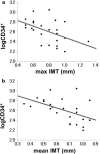Impact of glycemic variability on the levels of endothelial progenitor cells in patients with type 1 diabetes
- PMID: 30603358
- PMCID: PMC6224940
- DOI: 10.1007/s13340-017-0335-x
Impact of glycemic variability on the levels of endothelial progenitor cells in patients with type 1 diabetes
Abstract
Objective: A reduction in endothelial progenitor cell (EPC) count is considered to correlate with cumulative cardiovascular risk factors including hyperglycemia. This study was conducted to elucidate the influence of glycemic variability on EPC count in patients with diabetes.
Methods: In study 1, we examined the number of EPCs in 57 patients with type 1 diabetes and 43 patients with type 2 diabetes. The number of EPCs (CD34+, CD34+CD133+, CD34+CD309+, and CD34+CD133+CD309+) was counted as the number of cells per 106 events. In study 2, we examined 37 outpatients with type 1 diabetes without macrovascular complications. We assessed associations between EPC count and seven parameters of glycemic variability (blood glucose standard deviation, mean amplitude of glycemic excursion, J index, M value, mean of daily differences, low blood glucose index, and high blood glucose index), as measured by continuous glucose monitoring. We further analyzed the correlation between EPC count and the carotid intima-media thickness (IMT) in 24 patients.
Results: In study 1, the number of circulating CD34+ and CD34+CD133+ cells was significantly decreased in patients with type 1 diabetes relative to that in patients with type 2 diabetes (p = 0.020 and 0.036, respectively). In study 2, a univariate analysis showed that the J index was negatively correlated with logCD34+ (r = -0.342, p = 0.039). LogCD34+ was significantly negatively associated with the max IMT (r = -0.486, p = 0.012) and the mean IMT (r = -0.503, p = 0.016).
Conclusions: An increase in the J index, which reflects both hyperglycemia and glycemic variability, is associated with a reduction in the EPC count, which might result in the progression of diabetic vascular complications.
Keywords: Continuous glucose monitoring; Endothelial progenitor cells; Glycated albumin; Glycemic variability; Intima-media thickness; J index; Type 1 diabetes.
Conflict of interest statement
The authors declare that there are no conflicts of interest.All procedures followed were in accordance with the ethical standards of the responsible committee on human experimentation (institutional and national) and with the Helsinki Declaration of 1964 and later versions.Informed consent or a substitute for it was obtained from all patients before they were included in the study.
Figures
Similar articles
-
Circulating endothelial progenitor cells, endothelial function, carotid intima-media thickness and circulating markers of endothelial dysfunction in people with type 1 diabetes without macrovascular disease or microalbuminuria.Diabetologia. 2009 Aug;52(8):1464-73. doi: 10.1007/s00125-009-1401-0. Epub 2009 May 30. Diabetologia. 2009. PMID: 19484217
-
Increased CD34+/KDR+ cells are not associated with carotid artery intima-media thickness progression in chronic HIV-positive subjects.Antivir Ther. 2012;17(3):557-63. doi: 10.3851/IMP2013. Epub 2011 Dec 16. Antivir Ther. 2012. PMID: 22300770 Free PMC article.
-
Relationship between circulating endothelial progenitor cells and endothelial dysfunction in children with type 1 diabetes: a novel paradigm of early atherosclerosis in high-risk young patients.Eur J Endocrinol. 2013 Jan 17;168(2):153-61. doi: 10.1530/EJE-12-0857. Print 2013 Feb. Eur J Endocrinol. 2013. PMID: 23111589
-
Alterations in the Levels of Circulating and Endothelial Progenitor Cells Levels in Young Adults with Type 1 Diabetes: A 2-Year Follow-Up from the Observational METRO Study.Diabetes Metab Syndr Obes. 2020 Mar 18;13:777-784. doi: 10.2147/DMSO.S238588. eCollection 2020. Diabetes Metab Syndr Obes. 2020. PMID: 32256094 Free PMC article.
-
Reducing glucose variability with continuous subcutaneous insulin infusion increases endothelial progenitor cells in type 1 diabetes: an observational study.Endocrine. 2016 May;52(2):244-52. doi: 10.1007/s12020-015-0686-7. Epub 2015 Jul 17. Endocrine. 2016. PMID: 26184417
Cited by
-
Identification and Comparison of Hyperglycemia-Induced Extracellular Vesicle Transcriptome in Different Mouse Stem Cells.Cells. 2020 Sep 15;9(9):2098. doi: 10.3390/cells9092098. Cells. 2020. PMID: 32942572 Free PMC article.
-
NGF receptors and PI3K/AKT pathway involved in glucose fluctuation-induced damage to neurons and α-lipoic acid treatment.BMC Neurosci. 2020 Sep 17;21(1):38. doi: 10.1186/s12868-020-00588-y. BMC Neurosci. 2020. PMID: 32943002 Free PMC article.
-
Glucose Variability: How Does It Work?Int J Mol Sci. 2021 Jul 21;22(15):7783. doi: 10.3390/ijms22157783. Int J Mol Sci. 2021. PMID: 34360550 Free PMC article. Review.
-
Effects of glucose variability on hematopoietic stem/progenitor cells in patients with type 1 diabetes.J Endocrinol Invest. 2021 Jan;44(1):119-126. doi: 10.1007/s40618-020-01278-6. Epub 2020 May 4. J Endocrinol Invest. 2021. PMID: 32367464
-
Evaluating glucose variability through OGTT in early pregnancy and its association with hypertensive disorders of pregnancy in non-diabetic pregnancies: a large-scale multi-center retrospective study.Diabetol Metab Syndr. 2023 Jun 9;15(1):123. doi: 10.1186/s13098-023-01103-z. Diabetol Metab Syndr. 2023. PMID: 37296464 Free PMC article.
References
-
- Ross R. Atherosclerosis—an inflammatory disease. N Engl J Med. 1999;340:115–26. - PubMed
LinkOut - more resources
Full Text Sources
Research Materials

